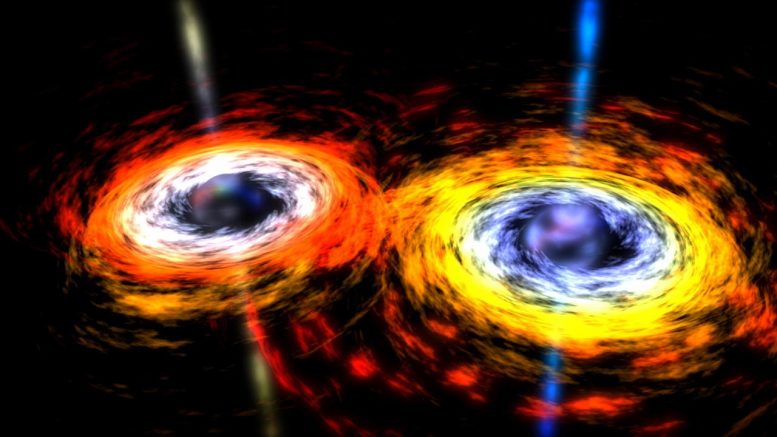
The formation and growth of supermassive black holes, potentially starting as intermediate-mass black holes, are being studied using advanced telescopes and observatories. These black holes are key to understanding early cosmic events and galaxy formation.
How do the most monstrous black holes in the universe form? It’s a mystery that could be solved by slightly smaller black holes – but there’s no firm evidence they exist.
In the vast garden of the universe, the heaviest black holes grew from seeds. Nourished by the gas and dust they consumed, or by merging with other dense objects, these seeds grew in size and heft to form the centers of galaxies, such as our own Milky Way. But unlike in the realm of plants, the seeds of giant black holes must have been black holes, too. And no one has ever found these seeds — yet.
One idea is that supermassive black holes — the equivalent of hundreds of thousands to billions of Suns in mass — grew from a population of smaller black holes that have never been seen. This elusive group, the “intermediate-mass black holes,” would weigh in somewhere between 100 and 100,000 Suns. Among the hundreds of black holes found so far, there have been plenty of relatively small ones, but none for sure in the intermediate mass-range “desert.”
The Hunt for Intermediate-Mass Black Holes
Scientists are working with powerful space telescopes from NASA, as well as other observatories, to track down far-flung objects that fit the description of these exotic entities. They have found dozens of possible candidates, and are working toward confirming them as black holes. But even if they do, that opens up a whole new mystery: How did intermediate-mass black holes form?
“What is fascinating, and why people have spent so much time trying to find these intermediate-mass black holes, is because it sheds light on processes that happened in the early universe— what were the masses of relic black holes, or new formation mechanisms for black holes that we haven’t thought of yet,” said Fiona Harrison, professor of physics at Caltech in Pasadena, California, and principal investigator for NASA’s NuSTAR mission.
Black Hole Basics and Supermassive Mysteries
A black hole is an extremely dense object in space from which no light can escape. When material falls into a black hole, it has no way out. And the more a black hole eats, the more it grows in both mass and size.
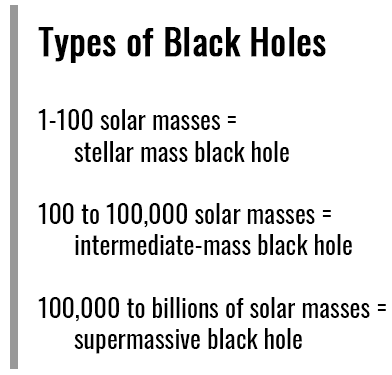
The smallest black holes are called “stellar mass,” with between 1 and 100 times the mass of the Sun. They form when stars explode in violent processes called supernovae.
Supermassive black holes, on the other hand, are the central anchors of large galaxies – for example, our Sun and all other stars in the Milky Way orbit a black hole called Sagittarius A* that weighs about 4.1 million solar masses. An even heavier black hole — at a whopping 6.5 billion solar masses — serves as the centerpiece for the galaxy Messier 87 (M87). M87’s supermassive black hole appears in the famous image from the Event Horizon Telescope, showing a black hole and its “shadow” for the very first time. This shadow is caused by the event horizon, the black hole’s point of no return, bending and capturing light with its strong gravity.
Supermassive black holes tend to have disks of material around them called “accretion disks,” made of extremely hot, high-energy particles that shine bright as they get closer to the event horizon— the black hole’s region of no return. Those that make their disks shine brightly because they eat a lot are called “active galactic nuclei.”
The density of matter needed to create a black hole is mind-boggling. To make a black hole 50 times the mass of the Sun, you would have to pack the equivalent of 50 Suns into a ball less than 200 miles (300 kilometers) across. But in the case of M87’s centerpiece, it is as though 6.5 billion Suns were compressed into a ball wider than the orbit of Pluto. In both cases, the density is so high that the original material must collapse into a singularity— a rip in the fabric of space-time.
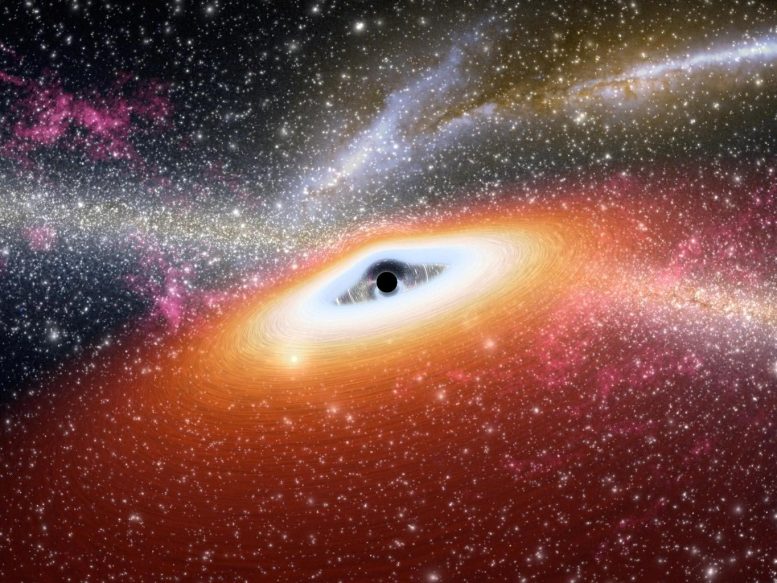
This artist’s conception illustrates one of the most primitive supermassive black holes known (central black dot) at the core of a young, star-rich galaxy. Credit: NASA/JPL-Caltech
Challenges in Black Hole Growth and Early Formation
Key to the mystery of black holes’ origins is the physical limit on how fast they can grow. Even the giant monsters at the centers of galaxies have limitations on their feeding frenzies, because a certain amount of material is pushed back by the high-energy radiation coming from hot particles accelerated near the event horizon. Just by eating surrounding material, a low-mass black hole might only be able to double its mass in 30 million years, for example.
“If you start from a mass of 50 solar masses, you simply cannot grow it to 1 billion solar masses over 1 billion years,” said Igor Chilingarian, an astrophysicist at the Smithsonian Astrophysical Observatory, Cambridge, Massachusetts, and Moscow State University. But, “as we know, there are supermassive black holes that exist less than 1 billion years after the formation of the universe.”
How To Make a Black Hole You Can’t See
Early in the universe’s history, the seed of an intermediate-mass black hole could have formed either from the collapse of a large, dense gas cloud or from a supernova explosion. The very first stars that exploded in our universe had pure hydrogen and helium in their outer layers with heavier elements concentrated in the core. This is a recipe for a much more massive black hole than exploding modern stars, which are “polluted” with heavy elements in their outer layers and therefore lose more mass through their stellar winds.
“If we’re forming black holes with 100 solar masses early in the universe, some of them should merge together, but you basically then should produce a whole range of masses, and then some of them should still be around,” said Tod Strohmayer, an astrophysicist at NASA’s Goddard Space Flight Center, Greenbelt, Maryland. “So then, where are they, if they did form?”
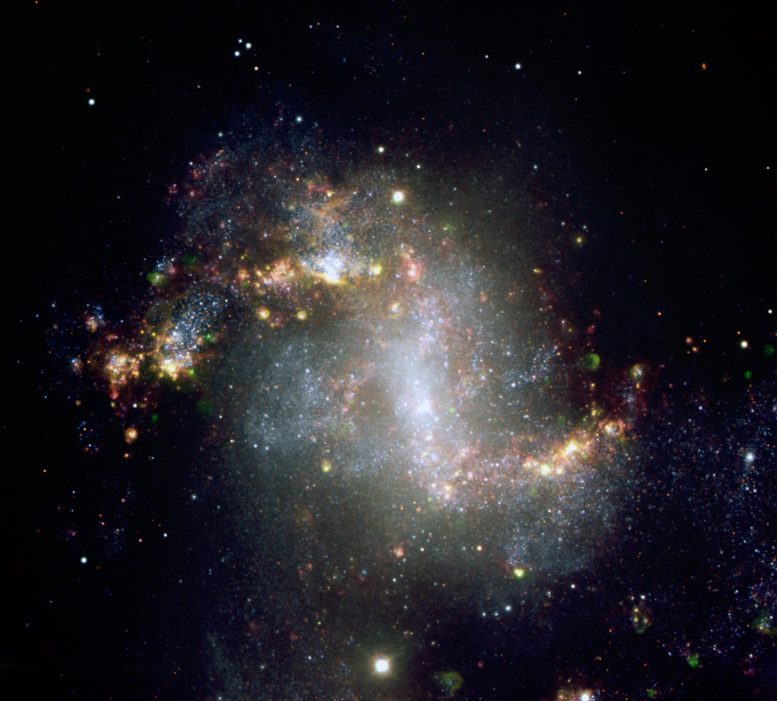
A galaxy called ESO 243-49, is home to an extremely bright object called HLX-1. Circled in this image, HLX-1 is the most likely example of a black hole in the intermediate mass range that scientists have found. Credit: NASA; ESA; and S. Farrell, Sydney Institute for Astronomy, University of Sydney
One clue that intermediate-mass black holes could still be out there came from the National Science Foundation’s Laser Interferometer Gravitational-Wave Observatory, LIGO, a collaboration between Caltech and the Massachusetts Institute of Technology. LIGO detectors, combined with a European facility in Italy named Virgo, are turning up many different mergers of black holes through ripples in space-time called gravitational waves.
In 2016, LIGO announced one of the most important scientific discoveries of the last half-century: the first gravitational wave detection. Specifically, the detectors based in Livingston, Louisiana, and Hanford, Washington, picked up the signal of two black holes merging. The masses of these black holes: 29 and 36 times the mass of the Sun, respectively, surprised scientists. While these are still not technically intermediate-mass, they are large enough to raise eyebrows.
It’s possible that all of the intermediate-mass black holes have already merged, but also that technology hasn’t been fine-tuned to locate them.
So Where Are They?
Looking for black holes in the intermediate-mass desert is tricky because black holes themselves emit no light. However, scientists can look for specific telltale signs using sophisticated telescopes and other instruments. For example, because the flow of matter onto a black hole is not constant, the clumpiness of consumed material causes certain variations in light output in the environment. Such changes can be seen more quickly in smaller black holes than in larger ones.
“On a timescale of hours, you can do the observational campaign that for classical active galactic nuclei takes months,” Chilingarian said.
The most promising intermediate-mass black hole candidate is called HLX-1, with a mass of about 20,000 times the Sun’s. HLX-1 stands for “Hyper-Luminous X-ray source 1,” and its energy output is a lot higher than Sun-like stars. It was discovered in 2009 by Australian astronomer Sean Farrell, using the European Space Agency’s XMM-Newton X-ray space telescope. A 2012 study using NASA’s Hubble and Swift space telescopes found suggestions of a cluster of young blue stars orbiting this object. It may have once been the center of a dwarf galaxy that was swallowed by the larger galaxy ESO 243-49. Many scientists consider HLX-1 a proven intermediate-mass black hole, Harrison said.
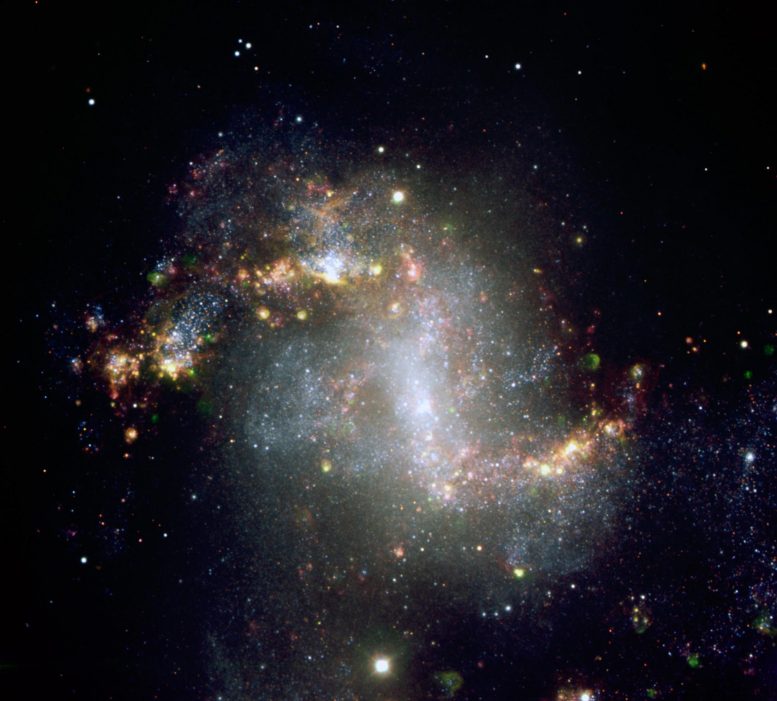
This image, taken with the European Southern Observatory’s Very Large Telescope, shows the central region of galaxy NGC1313. This galaxy is home to the ultraluminous X-ray source NCG1313X-1, which astronomers have now determined to be an intermediate-mass black hole candidate. NGC1313 is 50,000 light-years across and lies about 14 million light-years from the Milky Way in the southern constellation Reticulum. Credit: ESO
“The colors of X-ray light it emits, and just the way it behaves, is very similar to a black hole,” Harrison said. “A lot of people, including my group, have programs to find things that look like HLX-1, but so far none are consistent. But the hunt goes on.”
Less-bright objects that could be intermediate-mass black holes are called ultraluminous X-ray sources, or ULXs. A flickering ULX called NGC 5408 X-1 has been especially intriguing to scientists looking for intermediate-mass black holes. But NASA’s NuSTAR and Chandra X-ray observatories astonished scientists by revealing that many ULX objects are not black holes— instead, they are pulsars, extremely dense stellar remnants that appear to pulse like lighthouses.
M82 X-1, the brightest X-ray source in the galaxy M82, is another very bright object that seems to flicker on timescales consistent with an intermediate-mass black hole. These changes in brightness are related to the mass of the black hole, and are caused by orbiting material near the inner region of the accretion disk. A 2014 study looked at specific variations in X-ray light and estimated that M82 X-1 has a mass of about 400 Suns. Scientists used archival data from NASA’s Rossi X-ray Timing Explorer (RXTE) satellite to study these X-ray brightness variations.
Most recently, scientists investigated a bigger group of possible intermediate-mass black holes. In 2018, Chilingarian and colleagues described a sample of 10 candidates by re-analyzing optical data from the Sloan Digital Sky Survey and matching the initial prospects with X-ray data from Chandra and XMM-Newton. They are now following up with ground-based telescopes in Chile and Arizona. Mar Mezcua of Spain’s Institute for Space Sciences led a separate 2018 study, also using Chandra data, finding 40 growing black holes in dwarf galaxies that could be in that special intermediate-mass range. But Mezcua and collaborators argue these black holes formed originally in the collapse of giant clouds, rather than by originating in stellar explosions.
Future Tools and Technologies in Black Hole Research
Dwarf galaxies are interesting places to continue looking because, in theory, smaller star systems could host black holes of much lower mass than those found in the centers of larger galaxies like our own.
Scientists are also searching globular clusters — spherical concentrations of stars located in the outskirts of the Milky Way and other galaxies — for the same reason.
“It could be there are black holes like that, in galaxies like that, but if they’re not accreting a lot of matter, it might be hard to see them,” Strohmayer said.
Intermediate-mass black hole hunters eagerly await the launch of NASA’s James Webb Space Telescope, which will peer back to the dawn of the first galaxies. Webb will help astronomers figure out which came first — the galaxy or its central black hole — and how that black hole might have been put together. In combination with X-ray observations, Webb’s infrared data will be important for identifying some of the most ancient black hole candidates.
Another new tool launched in July by the Russian space agency Roscosmos is called Spectrum X-Gamma, a spacecraft that will scan the sky in X-rays, and carries an instrument with mirrors developed and built with NASA Marshall Space Flight Center, Huntsville, Alabama. Gravitational-wave information flowing from the LIGO-Virgo collaboration will also aid in the search, as will the European Space Agency’s planned Laser Interferometer Space Antenna (LISA) mission.
This fleet of new instruments and technologies, in addition to current ones, will help astronomers as they continue to scour the cosmic garden for seeds of black holes, and galaxies like our own.

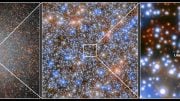







Please be aware that the theoretical foundation of your article: general relativity and big bang theory are based on the wrong concept called spacetime which does not exist in nature, not to mention the existences of singularities and ripples of spacetime because our physical time is absolute and independent of the 3D space as proved in the following:
The fatal mistake of special relativity is to equate relativistic time defined by Lorentz Transformation with the physical time defined by the status of physical processes such as physical clocks.
Let’s set two ideal trees: one is static and the other is moving at speed of v, both growing at the same rate r and having the same height H (which is calibrated as the physical time with a frame independent calibration constant k) observed at any relativistic time t in an inertial reference frame (x, y, z, t) of special relativity, then we have
H1 = H = r*t/k (1)
H2 = H = r*t/k (2)
with t1 = t, t2 = t, x1 = 0, x2 = v*t.
When these two trees are observed in the inertial reference frame (x’, y’, z’, t’) moving at speed v, we can use Lorentz Transformation to get
H1′ = H = r1’*t1’/k (3)
H2′ = H = r2’*t2’/k (4)
with x1′ = -v*t1′, x2′ = 0 and
t1′ = γ*(t1 – v*x1/c^2) = γ*(t – v*0/c^2) = γ*t (5)
t2′ = γ*(t2 – v*x2/c^2) = γ(t – v*(vt)/c^2) = t/γ (6)
because the heights of the trees do not experience Lorentz contraction caused by horizontal speed v.
From (1), (3) and (5), we have
r1′ = H*k/t1′ = (r*t/k)*k/(γ*t) = r/γ (7)
From (2), (4) and (6), we have
r2′ = H*k/t2′ = (r*t/k)*k/(t/γ) = γ*r (8)
That is, when the two trees are observed in the frame of (x’, y’, z’, t’), they still have the same height H (i.e. the same physical time), but have different relativistic times as shown by (5) and (6), and different growing rates as shown in (7) and (8).
Therefore, the physical time is Lorentz invariant and absolute, different from relativistic time which is just an artificial time defined by Lorentz Transformation to produce a fake constant speed of light, and thus all what STR describes is irrelevant to the real physical world.
As the physical time is absolute and independent of the 3D space, there is no such thing called spacetime in nature.
For more details in disproving special relativity, please check peer-reviewed published papers which are available free of charge at https://www.researchgate.net/publication/297527784_Challenge_to_the_Special_Theory_of_Relativity and https://www.researchgate.net/publication/297528348_Clock_Time_Is_Absolute_and_Universal .
Great post, Xinhang Shen. At the very least, thought provoking and actually questioning the status quo in astrophysics. Unfortunately, virtually no one within the mainstream dares question black holes, big bang, dark matter/energy, etc. This is all that’s taught in universities, and this is what is funded, so there’s no other intellectual/scientific frameworks for these scientists to refer to, and no money to be found for alternative and no doubt more legitimate, more scientifically based pursuits. Basically, all the black/dark “theories” are a cash cows because they’re so sensational. Einstein said it best, “Imagination is more important than knowledge.” That’s basically the guiding principal of astrophysics now, and where it was totally derailed. It’s imagination gone amok that’s created a virtual fairly land of mysterious, mystical, supernatural entities based on extreme assumptions, ideas, and speculations clothed in the guise of science, but without any real scientific foundation. Fantastic for capturing public imagination and money, toxic to real scientific progress.
Outrageous ideas need rigorous proofs. That’s what Einstein had to do when he theorized curved space-time. You’ll have to excuse us as we wait for you to generate referred papers proving this thing. You should try though, that’s how science progresses. But don’t claim success before you have conclusively proved it.
Physical clocks tick according to relativistic time. Atomic clocks are precise enough to show this effect even in our relatively mundane conditions.
The study of space is favorite of many people but I am curious to know what is unknown in space. In other words, I can say I have craze to know about mysterious things so I check info here about getting dissertation help to complete mine about black holes and such supermassive objects. I was researching for the content when I luckily find here the details about missing objects in enigma.
Your better bet is Wikipedia and Simple Wikipedia. Start there.
For black holes there’s a two part Nova series narrated by a Columbia University prof that’s really good.
Hi, I’m no scientist as you will probably know from my question,it just one idear that came up in a discussion with friends. If a black hole can survive for billions of years and in that lifetime it can merge with other black holes, whilst on this journey it’s eating up everything in its path,this may include small galaxies and in time bigger ones as the black hole gets bigger. All this matter that it consumes ends in a singularity. Is it possible over time that this becomes so dense that the black hole can no longer support this mass and exploding, an explosion so big and violent that it rips space apart and in that space creating a new universe. I’ve left a comment on ere before and can never find it again to see if my question was answered, if possible could someone email me with a response to this theory above. Kind regards
Even if a black hole exploded on the inside, we won’t be able to see anything outside the event horizon as no piece of the explosion can travel fast enough to escape.
As for as what’s happening inside the event horizon – no one knows.
The seeds of black holes are located in the Center of Our Universe: https://www.youtube.com/watch?v=tFUM3vAlaGc
A black hole in the Center of Our Universe is the matter of strings.
Black holes in the centers of galaxies are matter of quarks;
The black hole under the crown of stars is the matter of nucleons. We see them as sunspots. (See Galileo’s picture)
Particles of all these black matter are in every atom.
Wow, what an intriguing article about supermassive black holes! It’s fascinating to learn about the mysteries of the universe and how much we still have to discover.